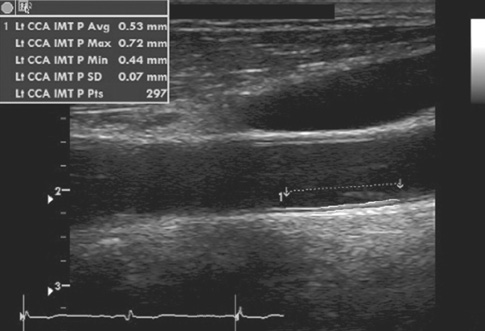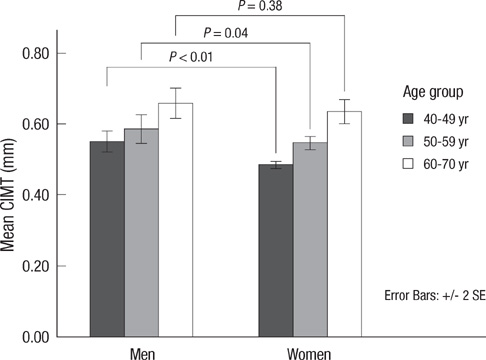J Korean Med Sci.
2011 Mar;26(3):365-371. 10.3346/jkms.2011.26.3.365.
Normative Values and Correlates of Mean Common Carotid Intima-Media Thickness in the Korean Rural Middle-aged Population: The Atherosclerosis RIsk of Rural Areas iN Korea General Population (ARIRANG) Study
- Affiliations
-
- 1Division of Cardiology, Internal Medicine, Wonju College of Medicine, Yonsei University, Wonju, Korea. kimjy@yonsei.ac.kr
- 2Institute of Genomic Cohort, Yonsei University, Wonju, Korea.
- 3Department of Preventive Medicine and Institute of Occupational Medicine, Wonju College of Medicine, Yonsei University, Wonju, Korea.
- KMID: 2157873
- DOI: http://doi.org/10.3346/jkms.2011.26.3.365
Abstract
- Carotid intima-media thickness (CIMT) is considered as a surrogate marker for cardiovascular disease (CVD). We determined the normative value of CIMT and correlates of CVD risk factors and Framingham risk score (FRS) in Korean rural middle-aged population. We measured CIMT with a B-mode ultrasonography in 1,759 subjects, aged 40 to 70 yr, in a population-based cohort in Korea. A healthy reference sample (n = 433) without CVD, normal weight and normal metabolic parameters was selected to establish normative CIMT values. Correlates between CIMT and conventional CVD risk factors were assessed in the entire population. Mean values of CIMT (in mm) for healthy reference sample aged 40-49, 50-59, and 60-70 yr were 0.55, 0.59, and 0.66 for men and 0.48, 0.55, and 0.63 for women, respectively. In multivariate regression analysis, CIMT was correlated with older age, higher BMI, male gender, higher LDL-cholesterol level and history of diabetes mellitus. The mean CIMT was also correlated with FRS in both gender (r2 = 0.043, P < 0.01 for men; r2 = 0.142, P < 0.01 for women). We identified normative value of CIMT for the healthy Korean rural middle-aged population. The CIMT is associated with age, obesity, gender, LDL-cholesterol, diabetes mellitus and FRS.
MeSH Terms
-
Adult
Aged
Atherosclerosis/epidemiology/*ultrasonography
Body Mass Index
Cardiovascular Diseases/epidemiology/*ultrasonography
Carotid Arteries/*ultrasonography
Cholesterol, LDL/blood
Cross-Sectional Studies
Diabetes Mellitus
Female
Humans
Male
Middle Aged
Reference Values
Republic of Korea
Risk Factors
Rural Health
Figure
Cited by 1 articles
-
Carotid duplex ultrasound: interpretations and clinical applications
Hye-Yeon Choi
Ann Clin Neurophysiol. 2021;23(2):82-91. doi: 10.14253/acn.2021.23.2.82.
Reference
-
1. Taylor AJ, Merz CN, Udelson JE. 34th Bethesda Conference: executive summary-can atherosclerosis imaging techniques improve the detection of patients at risk for ischemic heart disease? J Am Coll Cardiol. 2003. 41:1860–1862.2. Stein JH, Korcarz CE, Hurst RT, Lonn E, Kendall CB, Mohler ER, Najjar SS, Rembold CM, Post WS. American Society of Echocardiography Carotid Intima-Media Thickness Task Force. Use of carotid ultrasonography to identify subclinical vascular disease and evaluate cardiovascular disease risk: a consensus statement from the American Society of Echocardiography Carotid Intima-Media Thickness Task Force. Endorsed by the Society for Vascular Medicine. J Am Soc Echocardiogr. 2008. 21:93–111.3. Stein JH, Fraizer MC, Aeschlimann SE, Nelson-Worel J, McBride PE, Douglas PS. Vascular age: integrating carotid intima-media thickness measurements with global coronary risk assessment. Clin Cardiol. 2004. 27:388–392.4. Gepner AD, Keevil JG, Wyman RA, Korcarz CE, Aeschlimann SE, Busse KL, Stein JH. Use of carotid intima-media thickness and vascular age to modify cardiovascular risk prediction. J Am Soc Echocardiogr. 2006. 19:1170–1174.5. Greenland P, Abrams J, Aurigemma GP, Bond MG, Clark LT, Criqui MH, Crouse JR 3rd, Friedman L, Fuster V, Herrington DM, Kuller LH, Ridker PM, Roberts WC, Stanford W, Stone N, Swan HJ, Taubert KA, Wexler L. Prevention conference V: beyond secondary prevention; identifying the high-risk patient for primary prevention: noninvasive tests of atherosclerotic burden: Writing Group III. Circulation. 2000. 101:E16–E22.6. National Cholesterol Education Program (NCEP) Expert Panel on Detection, Evaluation, and Treatment of High Blood Cholesterol in Adults (Adult Treatment Panel III). Third report of the National Cholesterol Education Program (NCEP) Expert Panel on Detection, Evaluation, and Treatment of High Blood Cholesterol in Adults (Adult Treatment Panel III) final report. Circulation. 2002. 106:3143–3421.7. Naghavi M, Falk E, Hecht HS, Jamieson MJ, Kaul S, Berman D, Fayad Z, Budoff MJ, Rumberger J, Naqvi TZ, Shaw LJ, Faergeman O, Cohn J, Bahr R, Koenig W, Demirovic J, Arking D, Herrera VL, Badimon J, Goldstein JA, Rudy Y, Airaksinen J, Schwartz RS, Riley WA, Mendes RA, Douglas P, Shah PK. SHAPE Task Force. From vulnerable plaque to vulnerable patient--Part III: executive summary of the Screening for Heart Attack Prevention and Education (SHAPE) Task Force report. Am J Cardiol. 2006. 98:2H–15H.8. Mancia G, De Backer G, Dominiczak A, Cifkova R, Fagard R, Germano G, Grassi G, Heagerty AM, Kjeldsen SE, Laurent S, Narkiewicz K, Ruilope L, Rynkiewicz A, Schmieder RE, Struijker Boudier HA, Zanchetti A, Vahanian A, Camm J, De Caterina R, Dean V, Dickstein K, Filippatos G, Funck-Brentano C, Hellemans I, Kristensen SD, McGregor K, Sechtem U, Silber S, Tendera M, Widimsky P, Zamorano JL, Kjeldsen SE, Erdine S, Narkiewicz K, Kiowski W, Agabiti-Rosei E, Ambrosioni E, Cifkova R, Dominiczak A, Fagard R, Heagerty AM, Laurent S, Lindholm LH, Mancia G, Manolis A, Nilsson PM, Redon J, Schmieder RE, Struijker-Boudier HA, Viigimaa M, Filippatos G, Adamopoulos S, Agabiti-Rosei E, Ambrosioni E, Bertomeu V, Clement D, Erdine S, Farsang C, Gaita D, Kiowski W, Lip G, Mallion JM, Manolis AJ, Nilsson PM, O'Brien E, Ponikowski P, Redon J, Ruschitzka F, Tamargo J, van Zwieten P, Viigimaa M, Waeber B, Williams B, Zamorano JL. The task force for the management of arterial hypertension of the European Society of Hypertension. The task force for the management of arterial hypertension of the European Society of Cardiology. 2007 Guideline for the management of arterial hypertension: The Task Force for the Management of Arterial Hypertension of the European Society of Hypertension (ESH) and of the European Society of Cardiology (ESC). Eur Heart J. 2007. 28:1462–1536.9. O'Leary DH, Polak JF, Kronmal RA, Manolio TA, Burke GL, Wolfson SK Jr. Cardiovascular Health Study Collaborative Research Group. Carotid-artery intima and media thickness as a risk factor for myocardial infarction and stroke in older adults. N Engl J Med. 1999. 340:14–22.10. Thaulow E, Erikssen J, Sandvik L, Erikssen G, Jorgensen L, Cohn PF. Initial clinical presentation of cardiac disease in asymptomatic men with silent myocardial ischemia and angiographically documented coronary artery disease (the Oslo Ischemia Study). Am J Cardiol. 1993. 72:629–633.11. Chambless LE, Heiss G, Folsom AR, Folsom AR, Rosamond W, Szklo M, Sharrett AR, Clegg LX. Association of coronary heart disease incidence with carotid arterial wall thickness and major risk factors: the Atherosclerosis Risk in Communities (ARIC) study, 1987-1993. Am J Epidemiol. 1997. 146:483–494.12. Bae JH, Seung KB, Jung HO, Kim KY, Yoo KD, Kim CM, Cho SW, Cho SK, Kim YK, Rhee MY, Cho MC, Kim KS, Jin SW, Lee JM, Kim KS, Hyun DW, Cho YK, Seong IW, Jeong JO, Park SC, Jeong JY, Woo JT, Koh G, Lim SW. Analysis of Korean carotid intima-media thickness in Korean healthy subjects and patients with risk factors: Korea multi-center epidemiological study. Korean Circ J. 2005. 35:513–524.13. Cho YL, Kim DJ, Kim HD, Choi SH, Kim SK, Kim HJ, Ahn CW, Cha BS, Lim SK, Kim KR, Lee HC, Huh KB. Reference values of carotid intima-media thickness and association with atherosclerotic risk factors in healthy subjects in Korea. Korean J Med. 2003. 64:275–283.14. Muscelli E, Kozàkovà M, Flyvbjerg A, Kyriakopoulou K, Astiarraga BD, Glintborg D, Konrad T, Favuzzi A, Petrie J. RISC investigators. The effect of menopause on carotid artery remodeling, insulin sensitivity, and plasma adiponectin in healthy women. Am J Hypertens. 2009. 22:364–370.15. Brindle PM, McConnachie A, Upton MN, Hart CL, Davey Smith G, Watt GC. The accuracy of the Framingham risk-score in different socioeconomic groups: a prospective study. Br J Gen Pract. 2005. 55:838–845.
- Full Text Links
- Actions
-
Cited
- CITED
-
- Close
- Share
- Similar articles
-
- Gallstones are Associated with Intima-Media Thickness of Common Carotid Arteries in Men
- Do we need individual measurement of carotid intima and media thickness?
- The Relationship between Metabolic Syndrome and Intima-media Thickness of the Common Carotid Artery (IMT-CCA) in Young Adult Men
- Carotid ultrasound in patients with coronary artery disease
- Association between Carotid Artery Intima-Media Thickness and Stroke Risk Factors in Ischemic Stroke





